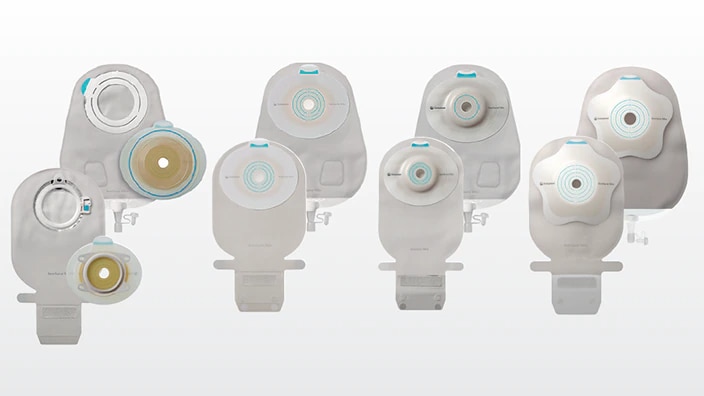Living with an ostomy
In general, your ostomy shouldn't keep you from working, socializing, playing sports, traveling or other hobbies. People with ostomies are completely capable of living fulfilling lives and return to normal activities after surgery. Your general state of health – physically as well as mentally – will play a big role in determining your quality of life as you move forward.
Get started with a pouching system

Having a stoma means you have no control over when you defecate or, in the case of a urostomy, when you urinate. This means that you always need to wear an ostomy pouch to collect your output. The most important thing to know is that your ostomy pouch should have a snug fit around your stoma. A snug fit helps prevent leakage and skin irritation.
Which ostomy pouch you use is a personal choice. Your ostomy nurse or doctor will provide you with pouches to get you off to a good start when you are discharged from the hospital. But as your body changes within the first couple of months, you may need to look into different pouching systems that better fit your needs. If you are experiencing complications with leakage, your skin or your product in general, always reach out to your doctor or ostomy nurse.
What is the best product solution for my body type?
After a stoma operation, your body profile may change for a number of reasons. These may include:
-
Weight gain or loss as you recover from the illness that caused the operation
-
Folds or scarring of the skin around your stoma
-
Hernia development related to your stoma
If your body profile changes, it’s important that you make sure your ostomy pouch still fits snugly to your abdomen. A tight seal between the appliance and your skin is essential for healthy skin around the stoma. If, for example, the area around your stoma changes from being regular to being more inwards, it may be time to switch to a convex appliance. You may also need to use additional accessories.
It is always a good idea to consult with your ostomy nurse about how your pouch fits and which accessories might work for you. Our online self-assessment tool, BodyCheck, will help you figure out your current body profile and whether your body has changed significantly. You will find suggestions for the right appliances and accessories to customize your fit. At Coloplast, we offer ostomy pouches and supporting products specific to your body shape for a better fit.
View pouching product solutions and request free samples
Keeping your skin healthy
Caring for your skin is an important part of living with an ostomy. In order for your pouching system to adhere properly, it is very important to keep the skin around your stoma healthy. The right accessories can help ensure that your pouch is adequately adhered to your abdomen to reduce risk of leakage and skin irritation. When the pouch is attached correctly, there is no risk of odor from your ostomy pouching system. Before you leave the hospital, you will be trained in how to change and empty your ostomy pouching system, and how to take care of your skin.
View our Brava Accessories- a range of ostomy accessories designed to reduce leakage and take care of your skin.
What can I eat and drink after ostomy surgery?
It's only natural to feel like your appetite has decreased after surgery. Your body is trying to heal and cope with the changes, and this may affect your eating habits. However, it's still important that you eat well and regularly. Studies show that your digestive system and bowel will return to normal quicker if you eat real food and a varied diet to support your gut bacteria. You may feel more comfortable if you start out carefully and limit your diet to easily digestible and protein rich foods. That may be bread and light carbs such as rice and pasta, chicken, turkey, fish, and steamed or boiled vegetables. Your ostomy nurse, surgeon or physician will advise if you need to take special precautions after surgery, both when you leave the hospital but also during regular check-ins. After a while, you can slowly reintroduce foods into your daily life and test your reaction, i.e. to spicy foods. red meat etc.